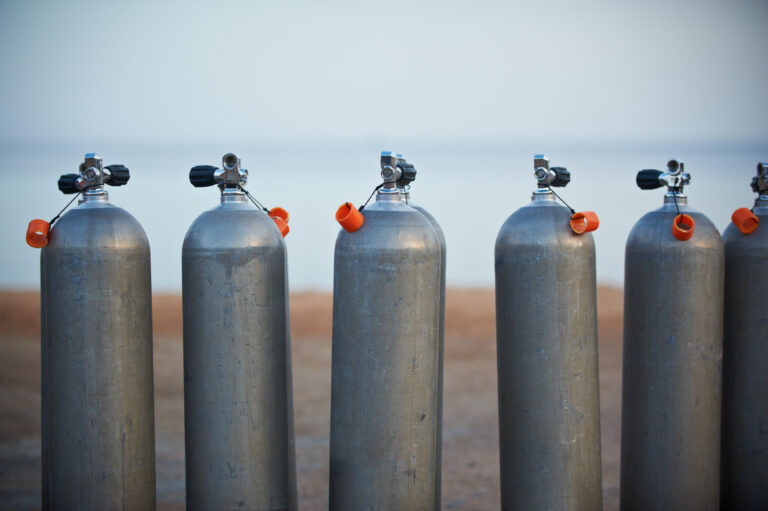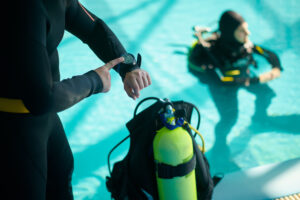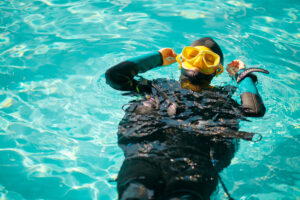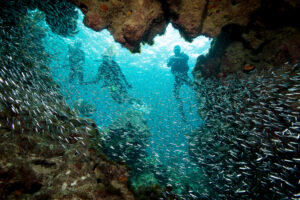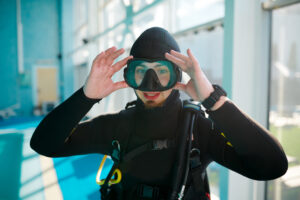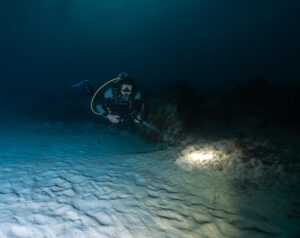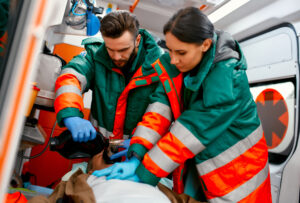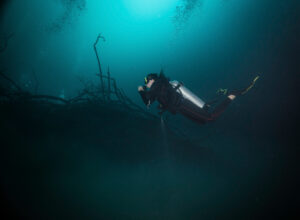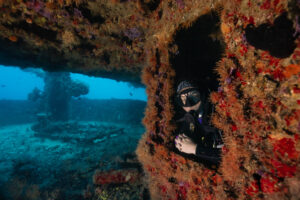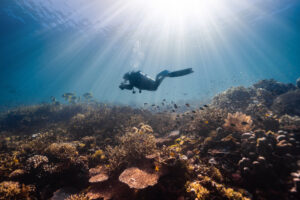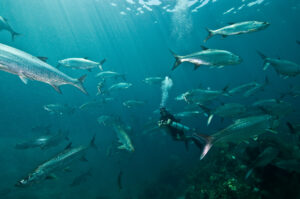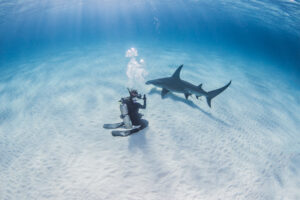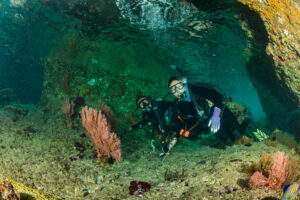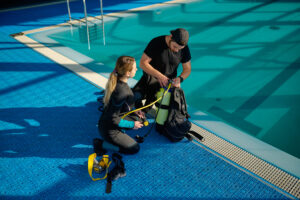What is Working Pressure?
Working Pressure (WP) is a critical parameter for scuba diving cylinders, as it indicates the maximum filling pressure rating for the cylinder at standard temperature. Understanding the concept of working pressure is essential for divers, as it directly impacts their safety underwater. This comprehensive entry will discuss the importance of working pressure, its determination, factors affecting it, and safety measures for divers.
Understanding Working Pressure
Working pressure tells us how much internal pressure a scuba tank can safely handle during normal use. It is usually listed in either pounds per square inch (psi) or bars, with 1 bar equal to about 14.5 psi. This rating is typically stamped on the tank’s shoulder so that it’s easy to see during inspections or filling.
This number isn’t just a label—it’s the standard that all other tank information builds from. Divers need it when calculating bottom time, gas consumption, and how deep they can safely dive. Filling a tank beyond this level introduces risk and can stress the metal over time, especially if repeated.
Pressure ratings also help match tanks to the right kind of regulator or valve. Not all equipment works with every pressure level, so matching gear correctly is key. Equipment used outside of its intended pressure range can wear out faster or even malfunction during a dive.
Determination of Working Pressure
Manufacturers determine a cylinder’s working pressure through engineering design and extensive testing. This process considers the material used to make the tank, its wall thickness, and the overall cylinder structure. The goal is to ensure that the tank stays strong enough to contain compressed gas without distortion or cracking.
Different materials handle pressure differently. Steel, for example, can usually support more pressure than aluminum due to its strength and resistance to stretching. That’s why some tanks made of steel are rated for higher pressures, while aluminum tanks are rated lower but are easier to handle and carry.
Before a tank ever reaches the hands of a diver, it must pass strict tests for strength and durability. These include pressure tests that go beyond normal operating conditions to confirm the tank won’t fail under stress. The result is a certified working pressure rating that divers and shops can rely on.
Steel Cylinders
Steel cylinders are often chosen for their strength and long lifespan. Many steel tanks can hold higher pressures, usually from 2320 psi (160 bar) up to 4500 psi (310 bar). This makes them a solid choice for dives that require a larger gas supply or more bottom time.
In addition to high pressure ratings, steel cylinders also tend to maintain neutral buoyancy better as gas is consumed. This can make managing position underwater a bit easier, especially for divers using minimal weights or diving in technical setups. Their reduced buoyancy shift adds a layer of predictability to the dive.
Though steel tanks are heavier on land, their stability underwater often makes the extra weight worthwhile. When maintained properly, they resist wear over time and continue to perform reliably across many years of use. Their strength also makes them less likely to deform or dent compared to softer metals.
Aluminum Cylinders
Aluminum cylinders are widely used by recreational divers because they are easier to handle out of the water. These tanks typically have working pressures ranging from 2015 psi (139 bar) to 3300 psi (227 bar), which still covers the needs of many common dive profiles.
While aluminum is more prone to buoyancy changes as gas is used, this can be managed with proper weighting. Divers just need to account for the positive shift during the dive. This quality makes aluminum tanks especially useful for shallow or medium-depth recreational dives where total gas volume is less of a concern.
The lighter construction also makes them more suitable for traveling, as many dive operations around the world use aluminum by default. While they may not last as long as steel in harsh environments, their ease of use and corrosion resistance still make them a dependable option for many divers.
Factors Affecting Working Pressure
Temperature
The working pressure of a scuba cylinder is based on a reference temperature of 70°F (21°C). This temperature provides a baseline for safe gas compression inside the tank. As the ambient temperature increases, the gas inside expands, which increases the internal pressure. Even modest temperature increases can push the pressure past the tank’s rated limits if it was filled close to the maximum.
High temperatures can occur if a cylinder is left in a car, exposed to the sun, or stored in a hot environment before a dive. These conditions may cause the pressure to rise beyond the design limit of the tank. On the other end of the scale, cold temperatures cause the gas to contract, reducing the pressure inside the cylinder. This may lead divers to believe they have less gas than expected, which can affect dive planning and safety.
Understanding how temperature shifts impact gas pressure is important in both storage and field use. Divers should avoid filling tanks to their maximum capacity in hot conditions and should always account for temperature differences when preparing for a dive. Equipment should also be stored in climate-controlled environments whenever possible to avoid stress caused by expanding or contracting gas.
Cylinder Age and Condition
As scuba cylinders are used over time, their internal and external conditions can degrade. Corrosion from moisture or saltwater, surface damage from impacts, and general wear all contribute to material fatigue. These changes reduce the structural integrity of the tank and lower its ability to safely hold high-pressure gas.
When damage occurs, even if it seems minor, it can introduce weak points where stress builds up during pressurization. These weak areas are not always visible to the naked eye, which is why regular testing is critical. A tank that appears intact on the outside might still fail a hydrostatic test due to changes in its internal elasticity or microscopic cracking.
Routine inspections are a requirement in most regions and serve as a vital safety check. A visual inspection should be performed at least annually, while hydrostatic testing is usually required every five years depending on local rules. If a tank fails any inspection, it should be removed from service to prevent possible injury or equipment damage.
Safety Measures for Divers
Adhering to Working Pressure
Sticking to the rated working pressure of a scuba cylinder is one of the simplest and most effective safety practices a diver can follow. Overfilling a tank places excess stress on its walls, increasing the risk of metal fatigue and, in rare cases, rupture. Filling beyond the recommended level may also invalidate the manufacturer’s warranty and inspection certifications.
When tanks are overfilled repeatedly, the structural changes may go unnoticed until a problem occurs. Small cracks, metal thinning, or seam failures can begin developing inside the cylinder due to high stress levels. These faults can then worsen over time, eventually leading to leaks or sudden failure. The consequences of such an event can be severe, especially if it occurs during transport or filling.
Filling stations play a key role in maintaining proper fill levels. Staff must always check the stamped pressure on the tank and verify it against the requested fill. Divers should also remain present during the filling process and speak up if they suspect an error. Sticking to the official rating helps protect both the diver and the integrity of the cylinder.
Proper Cylinder Inspection
Routine inspection of scuba cylinders ensures they are safe to use and remain within their designated working pressure. Visual inspections help identify corrosion, dents, cracks, and damage to the threads or valve openings. These checks are performed by certified professionals and are critical for catching early signs of deterioration.
Hydrostatic testing evaluates a cylinder’s ability to withstand high pressure. The test involves filling the tank with water, placing it inside a pressure vessel, and increasing internal pressure beyond its normal rating. If the tank expands more than the allowable limit or doesn’t return to its original shape, it fails the test. Cylinders that fail are permanently removed from service.
Both types of inspections are necessary and serve different purposes. Visual checks catch surface-level and visible internal issues, while hydrostatic tests confirm structural strength. Divers should never skip or delay these checks, even if the tank appears fine. Inspection records should be up to date and reviewed before every dive trip.
Appropriate Gas Mixtures
Each scuba cylinder has a working pressure that must match the gas mixture being used. Higher oxygen content, such as in Nitrox or other enriched air blends, can present additional risks if used in tanks not rated or cleaned for such gases. If the pressure is too high or the oxygen content exceeds safe limits, the risk of combustion or oxygen toxicity increases.
Tanks intended for high-oxygen mixtures are often specially cleaned and marked to reduce the risk of fire. Using enriched air in a tank that hasn’t been properly prepared can allow contaminants, such as oil or grease, to ignite under pressure. The working pressure and the cylinder’s cleaning certification must be checked before filling with any specialty blend.
For divers using trimix or other technical blends, matching the tank pressure rating with the intended fill is critical. Using the wrong gas in a tank that isn’t designed for it can result in inaccurate dive planning, inefficient gas use, or even medical emergencies. Staying within safe oxygen limits and confirming cylinder compatibility helps avoid these outcomes.
Buoyancy Considerations
Scuba cylinders made from different materials will behave differently in the water, especially as the gas is consumed. Steel tanks tend to remain more neutral in the water, while aluminum tanks often become positively buoyant near the end of a dive. This shift can affect the diver’s trim and position underwater.
Working pressure also plays a role in how buoyant a cylinder feels throughout the dive. Higher pressure tanks may carry more gas and therefore create a stronger negative buoyancy at the start of the dive. As the gas is used, that weight decreases, and buoyancy may increase depending on the cylinder type.
To manage this, divers should adjust their weight system to account for buoyancy changes during the dive. Knowing how a specific tank behaves under pressure helps prevent issues with maintaining depth or making a safe ascent. Buoyancy should be tested with full and nearly empty tanks during training to understand their behavior in real conditions.
Temperature Considerations
When diving in very warm or very cold environments, pressure changes due to temperature can have a noticeable effect. A tank filled in a cool dive shop and brought to a hot dive boat deck will show a significant rise in internal pressure. This can make the tank feel overfilled, even if it was within limits when first filled.
Cold water dives present different challenges. A tank that was filled to 3000 psi (207 bar) at room temperature might register much lower once submerged in near-freezing water. This can give the impression that gas is missing or lost, when in fact it has just contracted due to the temperature.
Dive planning should factor in where and how the tank was filled, as well as the expected water temperature. Divers may choose to underfill slightly in hot conditions or allow for some buffer if they’re diving in cold water. Being aware of temperature effects prevents confusion and helps maintain better control over gas usage and dive time.
Proper Storage and Handling
Storage conditions affect the long-term durability of scuba cylinders. Tanks should be kept in a cool, dry place, away from direct sunlight and not left in cars or other places where temperatures fluctuate wildly. Exposure to moisture can lead to rust, especially inside steel tanks if moisture gets in during filling.
Cylinders should be stored upright when possible and with some internal pressure remaining—usually around 200 psi (13.8 bar)—to prevent internal contamination. This small amount of pressure helps block moisture or other contaminants from entering. Storing them empty increases the risk of corrosion from humid air entering the tank.
Handling is equally important. Dropping or knocking over a tank, even when it appears undamaged, can lead to hidden weaknesses in the metal. Threads on the neck and valve are also vulnerable and must be checked regularly. Using tank boots and valve protectors helps limit the risk of damage during transport or storage.
Training and Awareness
Proper training helps divers understand how cylinder pressure affects overall safety and performance during a dive. This includes knowing how working pressure relates to depth limits, gas consumption rates, and emergency preparedness. Training programs often cover cylinder markings, valve types, and how to read pressure gauges, all of which are critical to handling equipment correctly.
Beyond the basics, divers benefit from advanced courses that include in-depth knowledge of gas properties, partial pressures, and pressure-related risks like oxygen toxicity or gas density at depth. These courses teach how to calculate safe limits using cylinder pressure as a guide. They also emphasize the importance of following established procedures when selecting and filling tanks.
As the diving industry evolves, new materials, technologies, and gas mixtures continue to emerge. Staying current with standards and recommended practices helps divers adjust their habits and equipment choices accordingly. Ongoing education, through refresher courses or updated certification programs, ensures divers stay informed and capable of making safe decisions regarding working pressure.
Equipment Compatibility
Every piece of diving equipment is designed to operate within a specific pressure range. Regulators, hoses, pressure gauges, and valves must all be compatible with the working pressure of the scuba cylinder they’re connected to. Using mismatched gear can result in leaks, performance issues, or complete equipment failure during a dive.
High-pressure tanks often require DIN valve systems, while lower-pressure tanks may use yoke-style connectors. These systems are not interchangeable without adapters, and using the wrong type can cause connection problems or damage the valve threads. Even with adapters, care must be taken to ensure they are rated for the tank’s pressure and used correctly.
It’s also important to check the pressure ratings stamped on regulators and hoses. Some regulators are only rated for use up to 3000 psi (207 bar), while others can handle up to 3500 psi (241 bar) or more. Divers should regularly inspect O-rings, connection points, and hoses for wear and ensure their gear is appropriate for the pressure they plan to use.
Gas Management
Managing air supply is one of the most important aspects of dive planning. The working pressure of a scuba cylinder determines how much breathing gas it can hold, which affects dive time and safety margins. Divers need to be aware of their gas consumption rate and plan accordingly, factoring in both the depth and the time they intend to stay underwater.
Checking tank pressure before and during a dive helps ensure there’s enough gas to return to the surface safely, with extra reserve for unexpected delays or emergencies. Dive computers and submersible pressure gauges (SPGs) allow real-time monitoring, but divers must also understand how to interpret those readings in relation to the tank’s capacity and their own usage patterns.
Gas management also includes calculating surface air consumption (SAC) rates and using that information to plan future dives. Knowing how much gas is used at different depths allows divers to choose the right cylinder for each situation. Keeping track of pressure readings throughout the dive, combined with good habits like slow breathing and controlled movements, improves gas efficiency and overall safety.
Emergency Procedures
In the rare event of a cylinder-related emergency, divers need to know how to respond quickly and calmly. Sudden pressure loss, such as from a burst disc or faulty valve, can lead to rapid gas depletion. Recognizing the signs early—such as an audible hissing sound or dropping gauge readings—is key to taking swift action and surfacing safely.
Divers should rehearse response techniques, including air-sharing drills, switching to an alternate air source, and controlled ascents. These procedures are standard in training courses but should be practiced regularly to stay fresh. In a high-pressure situation, muscle memory and confidence can make the difference between a controlled response and panic.
Even non-catastrophic issues, like slow leaks or pressure gauge malfunctions, require attention. A small leak that goes unnoticed can result in a shorter-than-expected dive or force an early exit from the water. Carrying out regular checks before and during the dive, paired with a clear understanding of emergency steps, helps divers handle pressure-related issues with confidence.
Key Takeaways
Understanding and respecting the working pressure of scuba diving cylinders is essential for ensuring diver safety and maintaining the integrity of the equipment. By adhering to the maximum filling pressure rating, conducting regular inspections, and following proper dive planning and gas management techniques, divers can minimize the risks associated with working pressure and enjoy their underwater adventures safely.

